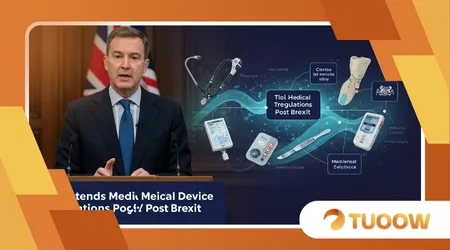UK Extends Medical Device Regulations Post-Brexit

Medical Device Regulation remains a cornerstone of the UK’s healthcare landscape, especially in 2025 as the nation navigates the post-Brexit era.
The recent extension of transitional arrangements for Medical Device Regulation, announced by the Medicines and Healthcare products Regulatory Agency (MHRA), ensures that devices compliant with EU standards can continue to be marketed in Great Britain until at least 2028.
This decision, rooted in pragmatism, addresses the complexities of regulatory divergence while safeguarding patient safety and fostering innovation.
But what does this mean for manufacturers, clinicians, and patients?
This article delves into the benefits of this extension, exploring its impact on supply chains, innovation, and public trust.
Through a blend of practical examples, real-world data, and sharp analysis, we’ll unpack why this move is a masterstroke for the UK’s medical device sector.
The post-Brexit regulatory landscape has been a tightrope walk.
After leaving the EU in 2020, the UK faced the daunting task of establishing its own Medical Device Regulation framework while maintaining access to global markets.
The MHRA’s decision to extend EU CE-marked device acceptance mitigates the risk of supply disruptions, particularly for critical devices like pacemakers and diagnostic tools.
This isn’t just about bureaucracy it’s about ensuring that hospitals aren’t left scrambling for life-saving equipment.
By aligning with EU standards temporarily, the UK buys time to refine its UKCA (UK Conformity Assessed) system, balancing sovereignty with practicality.
This article will argue that the extension is not merely a stopgap but a strategic move that bolsters economic stability, encourages innovation, and reinforces patient safety.
Let’s explore the multifaceted benefits of this decision.
Stabilizing Supply Chains in a Post-Brexit World
The extension of Medical Device Regulation transitional arrangements ensures uninterrupted access to EU-manufactured devices, critical for the NHS.
With 70% of medical devices in the UK historically sourced from the EU, any regulatory misalignment could have crippled supply chains.
The MHRA’s decision prevents this, allowing manufacturers to continue supplying CE-marked devices without immediate UKCA certification.
For instance, a Birmingham hospital relying on German-made ventilators can operate without fear of delays at customs.
This stability is vital for small and medium-sized enterprises (SMEs) that dominate the medical device sector.
These firms often lack the resources to navigate dual regulatory systems.
By extending the Medical Device Regulation transition, the MHRA reduces financial burdens, enabling SMEs to focus on production rather than paperwork.
This pragmatic approach keeps costs down, ultimately benefiting patients who rely on affordable devices.
Moreover, the extension mitigates the risk of shortages during global crises. The COVID-19 pandemic exposed vulnerabilities in medical supply chains, with ventilators and PPE in short supply.
By maintaining alignment with EU Medical Device Regulation, the UK ensures it remains part of a robust European supply network, ready to respond to future health emergencies.
++ Universal Credit Transition: What to Expect as ESA Transfer Completes
This isn’t just about today it’s about future-proofing healthcare.
The decision also fosters confidence among international manufacturers. A French company producing diagnostic kits, for example, can continue supplying the UK without re-certifying under UKCA.
This reduces trade friction, encouraging foreign investment in the UK’s healthcare market.
The extension is a diplomatic nod to global partners, signaling that the UK values collaboration over isolation.

Fostering Innovation Through Regulatory Clarity
Innovation thrives on certainty, and the Medical Device Regulation extension provides just that.
By delaying the full implementation of UKCA requirements, the MHRA gives manufacturers breathing room to develop cutting-edge technologies.
Consider a UK startup designing AI-powered prosthetics: without the pressure of immediate regulatory overhaul, it can focus on refining its product rather than chasing compliance.
This clarity also attracts global talent and investment. The UK’s life sciences sector, already a global leader, benefits from a stable regulatory environment.
According to a 2024 report by the Association of British HealthTech Industries (ABHI), 62% of UK medical device firms plan to increase R&D spending in 2025, citing regulatory stability as a key factor.
Also read: 30 Hours Free Childcare: Who Qualifies from September 2025?
This statistic underscores the extension’s role in driving innovation, ensuring the UK remains a hub for medical breakthroughs.
The extension also encourages collaboration between academia and industry.
Universities like Imperial College London, working on next-generation imaging devices, can partner with manufacturers without the specter of regulatory uncertainty.
This synergy accelerates the development of life-changing technologies, from wearable glucose monitors to robotic surgical tools.
Furthermore, the Medical Device Regulation extension allows the MHRA to refine its post-market surveillance systems.
By studying EU-compliant devices in real-world settings, the agency can gather data to shape a robust UKCA framework.
This iterative approach ensures that future regulations are evidence-based, fostering innovation without compromising safety.
Enhancing Patient Safety and Public Trust
Patient safety is the bedrock of Medical Device Regulation, and the extension reinforces this commitment.
By allowing CE-marked devices to remain on the market, the MHRA ensures that patients continue to access rigorously tested equipment.
For example, a diabetic patient using an insulin pump manufactured in Sweden can trust its reliability, knowing it meets stringent EU standards.
This decision also prevents a regulatory vacuum that could have allowed substandard devices to slip through the cracks.
Without the extension, manufacturers might have rushed to meet UKCA deadlines, potentially compromising quality.
The MHRA’s cautious approach prioritizes patient outcomes over political expediency, a move that rebuilds trust in post-Brexit governance.
Public trust is further bolstered by the extension’s transparency. The MHRA has committed to regular updates on the transition to UKCA, engaging stakeholders through consultations.
This openness contrasts with the opacity of early Brexit negotiations, signaling a new era of accountability in Medical Device Regulation.
Patients and clinicians alike benefit from this clarity, knowing their voices are heard.
The extension also aligns with global best practices. By maintaining compatibility with EU standards, the UK avoids isolating itself from international regulatory networks.
This ensures that patients benefit from devices vetted by multiple jurisdictions, enhancing confidence in the healthcare system.
Isn’t it reassuring to know that your heart monitor meets both UK and EU benchmarks?
Economic Benefits: A Win for Jobs and Growth
The economic ripple effects of the Medical Device Regulation extension are profound. The UK’s medical device sector employs over 100,000 people, and regulatory stability protects these jobs.
By avoiding a cliff-edge transition to UKCA, the MHRA prevents layoffs at firms struggling to comply with new rules, preserving livelihoods across the country.
This decision also boosts exports. UK manufacturers, like a Leeds-based company producing orthopedic implants, can continue selling CE-marked devices in the EU without dual certification.
This maintains access to a €150 billion European market, driving economic growth. The extension is a lifeline for exporters navigating post-Brexit trade barriers.
SMEs, which account for 85% of UK medical device firms, benefit disproportionately. These companies often operate on tight margins, and the cost of UKCA compliance could have been crippling.
By delaying this burden, the MHRA enables SMEs to invest in expansion, creating jobs and fueling local economies.
The extension also positions the UK as a global leader in health technology.
By aligning with EU Medical Device Regulation temporarily, the UK attracts foreign direct investment from firms eager to tap into a stable market.
This influx of capital strengthens the economy, ensuring long-term prosperity.
Bridging the Gap to a Sovereign Regulatory Future

The Medical Device Regulation extension is not a retreat from Brexit but a bridge to a sovereign future.
By granting manufacturers until 2028 to transition to UKCA, the MHRA allows time to build a world-class regulatory system tailored to UK needs.
This pragmatic approach balances national ambition with global realities.
The extension also enables the MHRA to learn from international counterparts. By observing EU regulatory updates, the agency can adopt best practices while avoiding pitfalls.
For instance, the EU’s recent focus on cybersecurity for connected devices could inform UKCA standards, ensuring future-proof regulations.
Stakeholder engagement is another benefit. The MHRA’s consultations with manufacturers, clinicians, and patients ensure that UKCA reflects diverse perspectives.
This inclusive approach contrasts with the top-down EU system, offering a chance to craft regulations that prioritize UK-specific challenges, like rural healthcare access.
Finally, the extension buys time to address capacity issues. The UK currently lacks enough approved bodies to certify devices under UKCA.
By delaying full implementation, the MHRA can expand this infrastructure, ensuring a smooth transition to a sovereign Medical Device Regulation framework.
A Strategic Analogy: The Regulatory Tightrope
Think of the Medical Device Regulation extension as a tightrope walker’s balancing pole.
On one side, there’s the need for sovereignty and a bespoke UKCA system; on the other, the practical demands of supply chains, innovation, and patient safety.
The MHRA’s decision steadies the walker, allowing the UK to move forward without falling into chaos.
This analogy captures the delicate equilibrium the extension achieves, blending ambition with pragmatism.
| Aspect | EU CE Mark | UKCA (Future) |
|---|---|---|
| Market Access | EU + UK (until 2028) | UK only |
| Certification Cost | €10,000–€50,000 | Estimated €15,000–€70,000 |
| Transition Deadline | June 2028 | Full implementation TBD |
| Regulatory Body | EU Notified Bodies | UK Approved Bodies |
Conclusion: A Bold Step Toward a Healthier Future
The extension of Medical Device Regulation transitional arrangements is a triumph of foresight over haste.
By preserving access to EU-compliant devices, the MHRA safeguards supply chains, fuels innovation, and protects patients.
This isn’t about clinging to the EU it’s about building a robust UKCA system without sacrificing stability.
From SMEs in Manchester to global giants in London, the benefits are tangible: jobs preserved, innovations unleashed, and trust restored.
As the UK charts its post-Brexit path, this decision proves that pragmatism can coexist with ambition. What’s next for the UK’s medical device sector?
Only time will tell, but for now, the future looks steady, safe, and full of promise.
Frequently Asked Questions
Q: Why was the Medical Device Regulation extension necessary?
A: The extension prevents supply chain disruptions and gives manufacturers time to adapt to UKCA, ensuring patient access to safe devices.
Q: How does the extension impact patients?
A: Patients benefit from continued access to EU-approved devices, maintaining high safety standards without interruptions in care.
Q: Will the UKCA system replace EU regulations entirely?
A: Yes, by 2028, UKCA is expected to fully replace EU CE marks, tailored to UK-specific needs.
Q: What happens if manufacturers miss the 2028 deadline?
A: Non-compliant devices may be removed from the UK market, emphasizing the need for timely preparation.
